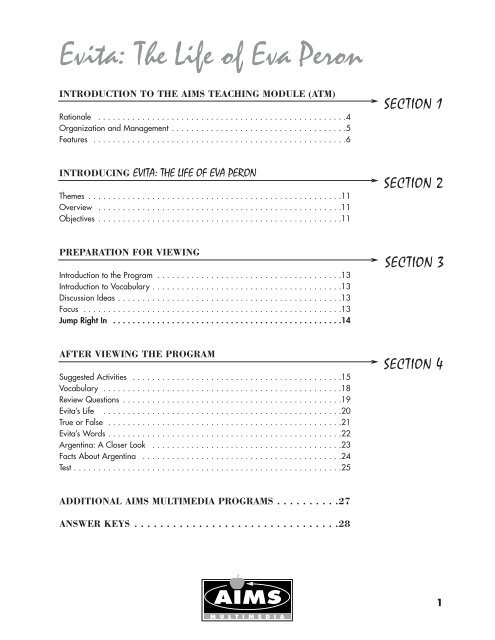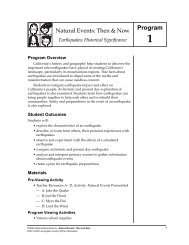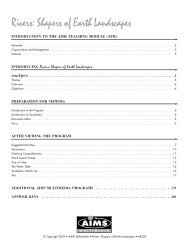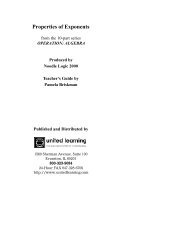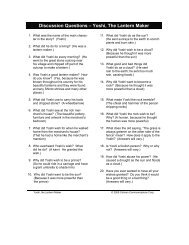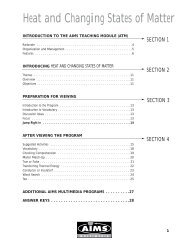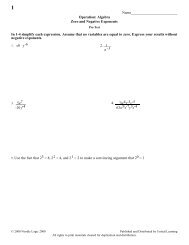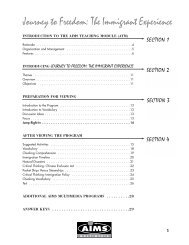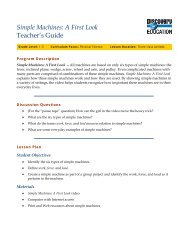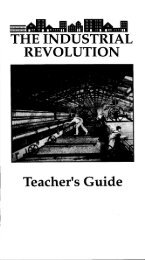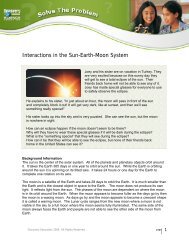Evita: The Life of Eva Peron - Discovery Education
Evita: The Life of Eva Peron - Discovery Education
Evita: The Life of Eva Peron - Discovery Education
You also want an ePaper? Increase the reach of your titles
YUMPU automatically turns print PDFs into web optimized ePapers that Google loves.
<strong>Evita</strong>: <strong>The</strong> <strong>Life</strong> <strong>of</strong> <strong>Eva</strong> <strong>Peron</strong><br />
INTRODUCTION TO THE AIMS TEACHING MODULE (ATM)<br />
Rationale . . . . . . . . . . . . . . . . . . . . . . . . . . . . . . . . . . . . . . . . . . . . . . . . . . .4<br />
Organization and Management . . . . . . . . . . . . . . . . . . . . . . . . . . . . . . . . . . . .5<br />
Features . . . . . . . . . . . . . . . . . . . . . . . . . . . . . . . . . . . . . . . . . . . . . . . . . . . .6<br />
SECTION 1<br />
INTRODUCING EVITA: THE LIFE OF EVA PERON<br />
<strong>The</strong>mes . . . . . . . . . . . . . . . . . . . . . . . . . . . . . . . . . . . . . . . . . . . . . . . . . . . .11<br />
Overview . . . . . . . . . . . . . . . . . . . . . . . . . . . . . . . . . . . . . . . . . . . . . . . . . .11<br />
Objectives . . . . . . . . . . . . . . . . . . . . . . . . . . . . . . . . . . . . . . . . . . . . . . . . . .11<br />
SECTION 2<br />
PREPARATION FOR VIEWING<br />
Introduction to the Program . . . . . . . . . . . . . . . . . . . . . . . . . . . . . . . . . . . . . .13<br />
Introduction to Vocabulary . . . . . . . . . . . . . . . . . . . . . . . . . . . . . . . . . . . . . . .13<br />
Discussion Ideas . . . . . . . . . . . . . . . . . . . . . . . . . . . . . . . . . . . . . . . . . . . . . .13<br />
Focus . . . . . . . . . . . . . . . . . . . . . . . . . . . . . . . . . . . . . . . . . . . . . . . . . . . . .13<br />
Jump Right In . . . . . . . . . . . . . . . . . . . . . . . . . . . . . . . . . . . . . . . . . . . . . . .14<br />
SECTION 3<br />
AFTER VIEWING THE PROGRAM<br />
Suggested Activities . . . . . . . . . . . . . . . . . . . . . . . . . . . . . . . . . . . . . . . . . . .15<br />
Vocabulary . . . . . . . . . . . . . . . . . . . . . . . . . . . . . . . . . . . . . . . . . . . . . . . . .18<br />
Review Questions . . . . . . . . . . . . . . . . . . . . . . . . . . . . . . . . . . . . . . . . . . . . .19<br />
<strong>Evita</strong>’s <strong>Life</strong> . . . . . . . . . . . . . . . . . . . . . . . . . . . . . . . . . . . . . . . . . . . . . . . . .20<br />
True or False . . . . . . . . . . . . . . . . . . . . . . . . . . . . . . . . . . . . . . . . . . . . . . . .21<br />
<strong>Evita</strong>’s Words . . . . . . . . . . . . . . . . . . . . . . . . . . . . . . . . . . . . . . . . . . . . . . . .22<br />
Argentina: A Closer Look . . . . . . . . . . . . . . . . . . . . . . . . . . . . . . . . . . . . . . .23<br />
Facts About Argentina . . . . . . . . . . . . . . . . . . . . . . . . . . . . . . . . . . . . . . . . .24<br />
Test . . . . . . . . . . . . . . . . . . . . . . . . . . . . . . . . . . . . . . . . . . . . . . . . . . . . . . .25<br />
SECTION 4<br />
ADDITIONAL AIMS MULTIMEDIA PROGRAMS . . . . . . . . . .27<br />
ANSWER KEYS . . . . . . . . . . . . . . . . . . . . . . . . . . . . . . . .28<br />
1
© Copyright 1999 AIMS Multimedia<br />
All Rights Reserved. No part <strong>of</strong> this work may be reproduced or transmitted without written permission <strong>of</strong> AIMS<br />
Multimedia with these exceptions: Persons or schools purchasing this AIMS Teaching Module may reproduce<br />
consumable ATM pages, identified in Section 4, for student or classroom use.<br />
AIMS Multimedia is a leading producer and distributor <strong>of</strong> educational programs serving schools and libraries for<br />
nearly 40 years. AIMS draws upon the most up-to-date knowledge, existing and emerging technologies, and all <strong>of</strong><br />
the instructional and pedagogical resources available to develop and distribute educational programs<br />
in film, videocassette, laserdisc, CD-ROM and CD-i formats.<br />
Persons or schools interested in obtaining additional copies <strong>of</strong> this AIMS Teaching Module, please contact:<br />
AIMS Multimedia<br />
1-800-FOR-AIMS<br />
1-800-367-2467<br />
2<br />
© Copyright 2003 AIMS Multimedia
Congratulations!<br />
You have chosen a learning program<br />
that will actively motivate your students<br />
AND provide you with easily accessible<br />
and easily manageable instructional<br />
guidelines designed to make your<br />
teaching role efficient and rewarding.<br />
<strong>The</strong> AIMS Teaching Module provides<br />
you with a video program keyed to your<br />
classroom curriculum, instructions and<br />
guidelines for use, plus a comprehensive<br />
teaching program containing a<br />
wide range <strong>of</strong> activities and ideas for<br />
interaction between all content areas.<br />
Our authors, educators, and consultants<br />
have written and reviewed the AIMS<br />
Teaching Modules to align with the<br />
Educate America Act: Goals 2000.<br />
This ATM, with its clear definition <strong>of</strong><br />
manageability, both in the classroom<br />
and beyond, allows you to tailor specific<br />
activities to meet all <strong>of</strong> your classroom<br />
needs.<br />
© Copyright 2003 AIMS Multimedia<br />
3
RATIONALE<br />
In today’s classrooms, educational pedagogy<br />
is <strong>of</strong>ten founded on Benjamin S.<br />
Bloom’s “Six Levels <strong>of</strong> Cognitive<br />
Complexity.” <strong>The</strong> practical application<br />
<strong>of</strong> Bloom’s Taxonomy is to evaluate students’<br />
thinking skills on these levels,<br />
from the simple to the complex:<br />
Knowledge (rote memory skills),<br />
Comprehension (the ability to relate or<br />
retell), Application (the ability to apply<br />
knowledge outside its origin), Analysis<br />
(relating and differentiating parts <strong>of</strong> a<br />
whole), Synthesis (relating parts to a<br />
whole), and <strong>Eva</strong>luation (making a judgment<br />
or formulating an opinion).<br />
<strong>The</strong> AIMS Teaching Module is designed<br />
to facilitate these intellectual capabilities,<br />
AND to integrate classroom experiences<br />
and assimilation <strong>of</strong> learning<br />
with the students’ life experiences, realities,<br />
and expectations. AIMS’ learner<br />
verification studies prove that our AIMS<br />
Teaching Modules help students to<br />
absorb, retain, and to demonstrate ability<br />
to use new knowledge in their world.<br />
Our educational materials are written<br />
and designed for today’s classroom,<br />
which incorporates a wide range <strong>of</strong><br />
intellectual, cultural, physical, and emotional<br />
diversities.<br />
4<br />
© Copyright 2003 AIMS Multimedia
ORGANIZATION AND<br />
MANAGEMENT<br />
To facilitate ease in classroom manageability,<br />
the AIMS Teaching Module is<br />
organized in four sections. You are<br />
reading Section 1, Introduction to the<br />
Aims Teaching Module (ATM).<br />
SECTION 2,<br />
INTRODUCING THIS ATM<br />
will give you the specific information<br />
you need to integrate the program into<br />
your classroom curriculum.<br />
SECTION 3,<br />
PREPARATION FOR VIEWING<br />
provides suggestions and strategies for<br />
motivation, language preparedness,<br />
readiness, and focus prior to viewing<br />
the program with your students.<br />
SECTION 4,<br />
AFTER VIEWING THE PROGRAM<br />
provides suggestions for additional<br />
activities plus an assortment <strong>of</strong> consumable<br />
assessment and extended activities,<br />
designed to broaden comprehension <strong>of</strong><br />
the topic and to make connections to<br />
other curriculum content areas.<br />
© Copyright 2003 AIMS Multimedia<br />
5
FEATURES<br />
INTRODUCING EACH ATM<br />
SECTION 2<br />
Your AIMS Teaching Module is<br />
designed to accompany a video program<br />
written and produced by some <strong>of</strong><br />
the world’s most credible and creative<br />
writers and producers <strong>of</strong> educational<br />
programming. To facilitate diversity and<br />
flexibility in your classroom, your AIMS<br />
Teaching Module features these components:<br />
<strong>The</strong>mes<br />
<strong>The</strong> Major <strong>The</strong>me tells how this AIMS<br />
Teaching Module is keyed into the curriculum.<br />
Related <strong>The</strong>mes <strong>of</strong>fer suggestions<br />
for interaction with other<br />
curriculum content areas, enabling<br />
teachers to use the teaching module to<br />
incorporate the topic into a variety <strong>of</strong><br />
learning areas.<br />
Overview<br />
<strong>The</strong> Overview provides a synopsis <strong>of</strong><br />
content covered in the video program.<br />
Its purpose is to give you a summary <strong>of</strong><br />
the subject matter and to enhance your<br />
introductory preparation.<br />
Objectives<br />
<strong>The</strong> ATM learning objectives provide<br />
guidelines for teachers to assess what<br />
learners can be expected to gain from<br />
each program. After completion <strong>of</strong> the<br />
AIMS Teaching Module, your students<br />
will be able to demonstrate dynamic<br />
and applied comprehension <strong>of</strong> the<br />
topic.<br />
6<br />
© Copyright 2003 AIMS Multimedia
PREPARATION FOR VIEWING<br />
SECTION 3<br />
In preparation for viewing the video<br />
program, the AIMS Teaching Module<br />
<strong>of</strong>fers activity and/or discussion<br />
ideas that you may use in any order<br />
or combination.<br />
Introduction To <strong>The</strong> Program<br />
Introduction to the Program is<br />
designed to enable students to recall<br />
or relate prior knowledge about the<br />
topic and to prepare them for what<br />
they are about to learn.<br />
Introduction To Vocabulary<br />
Introduction to Vocabulary is a<br />
review <strong>of</strong> language used in the program:<br />
words, phrases, usage. This<br />
vocabulary introduction is designed to<br />
ensure that all learners, including limited<br />
English pr<strong>of</strong>iciency learners, will<br />
have full understanding <strong>of</strong> the language<br />
usage in the content <strong>of</strong> the program.<br />
Discussion Ideas<br />
Discussion Ideas are designed to help<br />
you assess students’ prior knowledge<br />
about the topic and to give students a<br />
preview <strong>of</strong> what they will learn.<br />
Active discussion stimulates interest in<br />
a subject and can motivate even the<br />
most reluctant learner. Listening, as<br />
well as speaking, is active participation.<br />
Encourage your students to participate<br />
at the rate they feel<br />
comfortable. Model sharing personal<br />
experiences when applicable, and<br />
model listening to students’ ideas and<br />
opinions.<br />
Focus<br />
Help learners set a purpose for<br />
watching the program with Focus,<br />
designed to give students a focal<br />
point for comprehension continuity.<br />
Jump Right In<br />
Jump Right In provides abbreviated<br />
instructions for quick management <strong>of</strong><br />
the program.<br />
AFTER VIEWING THE PROGRAM<br />
SECTION 4<br />
After your students have viewed the<br />
program, you may introduce any or<br />
all <strong>of</strong> these activities to interact with<br />
other curriculum content areas, provide<br />
reinforcement, assess comprehension<br />
skills, or provide hands-on<br />
and in-depth extended study <strong>of</strong> the<br />
topic.<br />
© Copyright 2003 AIMS Multimedia<br />
7
SUGGESTED<br />
ACTIVITIES<br />
<strong>The</strong> Suggested Activities <strong>of</strong>fer ideas<br />
for activities you can direct in the<br />
classroom or have your students complete<br />
independently, in pairs, or in<br />
small work groups after they have<br />
viewed the program. To accommodate<br />
your range <strong>of</strong> classroom needs,<br />
the activities are organized into skills<br />
categories. <strong>The</strong>ir labels will tell you<br />
how to identify each activity and help<br />
you correlate it into your classroom<br />
curriculum. To help you schedule your<br />
classroom lesson time, the AIMS<br />
hourglass gives you an estimate <strong>of</strong> the<br />
time each activity should require.<br />
Some <strong>of</strong> the activities fall into these<br />
categories:<br />
Meeting Individual<br />
Needs<br />
<strong>The</strong>se activities are designed to aid in<br />
classroom continuity. Reluctant learners<br />
and learners acquiring English<br />
will benefit from these activities<br />
geared to enhance comprehension <strong>of</strong><br />
language in order to fully grasp content<br />
meaning.<br />
MATH<br />
Curriculum<br />
Connections<br />
Many <strong>of</strong> the suggested activities are<br />
intended to integrate the content <strong>of</strong><br />
the ATM program into other content<br />
areas <strong>of</strong> the classroom curriculum.<br />
<strong>The</strong>se cross-connections turn the<br />
classroom teaching experience into a<br />
whole learning experience.<br />
Critical Thinking<br />
Critical Thinking activities are<br />
designed to stimulate learners’ own<br />
opinions and ideas. <strong>The</strong>se activities<br />
require students to use the thinking<br />
process to discern fact from opinion,<br />
consider their own problems and formulate<br />
possible solutions, draw conclusions,<br />
discuss cause and effect, or<br />
combine what they already know<br />
with what they have learned to make<br />
inferences.<br />
Cultural Diversity<br />
Each AIMS Teaching Module has an<br />
activity called Cultural Awareness,<br />
Cultural Diversity, or Cultural<br />
Exchange that encourages students to<br />
share their backgrounds, cultures,<br />
heritage, or knowledge <strong>of</strong> other countries,<br />
customs, and language.<br />
Hands On<br />
<strong>The</strong>se are experimental or tactile<br />
activities that relate directly to the<br />
material taught in the program.Your<br />
students will have opportunities to<br />
make discoveries and formulate ideas<br />
on their own, based on what they<br />
learn in this unit.<br />
Writing<br />
Every AIMS Teaching Module will<br />
contain an activity designed for students<br />
to use the writing process to<br />
express their ideas about what they<br />
have learned. <strong>The</strong> writing activity<br />
may also help them to make the connection<br />
between what they are learning<br />
in this unit and how it applies to<br />
other content areas.<br />
In <strong>The</strong> Newsroom<br />
Each AIMS Teaching Module contains<br />
a newsroom activity designed to help<br />
students make the relationship<br />
between what they learn in the classroom<br />
and how it applies in their<br />
world. <strong>The</strong> purpose <strong>of</strong> In <strong>The</strong><br />
Newsroom is to actively involve each<br />
class member in a whole learning<br />
experience. Each student will have an<br />
opportunity to perform all <strong>of</strong> the tasks<br />
involved in production: writing,<br />
researching, producing, directing,<br />
and interviewing as they create their<br />
own classroom news program.<br />
Extended Activities<br />
<strong>The</strong>se activities provide opportunities<br />
for students to work separately or<br />
together to conduct further research,<br />
explore answers to their own questions,<br />
or apply what they have<br />
learned to other media or content<br />
areas.<br />
Link to the World<br />
<strong>The</strong>se activities <strong>of</strong>fer ideas for connecting<br />
learners’ classroom activities<br />
to their community and the rest <strong>of</strong> the<br />
world.<br />
Culminating Activity<br />
To wrap up the unit, AIMS Teaching<br />
Modules <strong>of</strong>fer suggestions for ways to<br />
reinforce what students have learned<br />
and how they can use their new<br />
knowledge to enhance their world<br />
view.<br />
8<br />
© Copyright 2003 AIMS Multimedia
VOCABULARY<br />
Every ATM contains an activity that<br />
reinforces the meaning and usage <strong>of</strong><br />
the vocabulary words introduced in<br />
the program content. Students will<br />
either read or find the definition <strong>of</strong><br />
each vocabulary word, then use the<br />
word in a written sentence.<br />
CHECKING<br />
COMPREHENSION<br />
Checking Comprehension is designed<br />
to help you evaluate how well your<br />
students understand, retain, and<br />
recall the information presented in the<br />
AIMS Teaching Module. Depending<br />
on your students’ needs, you may<br />
direct this activity to the whole group<br />
yourself, or you may want to have<br />
students work on the activity page<br />
independently, in pairs, or in small<br />
groups. Students can verify their written<br />
answers through discussion or by<br />
viewing the video a second time. If<br />
you choose, you can reproduce the<br />
answers from your Answer Key or<br />
write the answer choices in a Word<br />
Bank for students to use. Students can<br />
use this completed activity as a study<br />
guide to prepare for the test.<br />
CONSUMABLE<br />
ACTIVITIES<br />
<strong>The</strong> AIMS Teaching Module provides<br />
a selection <strong>of</strong> consumable activities,<br />
designed to specifically reinforce the<br />
content <strong>of</strong> this learning unit.<br />
Whenever applicable, they are<br />
arranged in order from low to high<br />
difficulty level, to allow a seamless<br />
facilitation <strong>of</strong> the learning process.<br />
You may choose to have students take<br />
these activities home or to work on<br />
them in the classroom independently,<br />
in pairs or in small groups.<br />
CHECKING<br />
VOCABULARY<br />
<strong>The</strong> Checking Vocabulary activity<br />
provides the opportunity for students<br />
to assess their knowledge <strong>of</strong> new<br />
vocabulary with this word game or<br />
puzzle. <strong>The</strong> format <strong>of</strong> this vocabulary<br />
activity allows students to use the<br />
related words and phrases in a different<br />
context.<br />
TEST<br />
<strong>The</strong> AIMS Teaching Module Test permits<br />
you to assess students’ understanding<br />
<strong>of</strong> what they have learned.<br />
<strong>The</strong> test is formatted in one <strong>of</strong> several<br />
standard test formats to give your<br />
students a range <strong>of</strong> experiences in<br />
test-taking techniques. Be sure to<br />
read, or remind students to read, the<br />
directions carefully and to read each<br />
answer choice before making a<br />
selection. Use the Answer Key to<br />
check their answers.<br />
© Copyright 2003 AIMS Multimedia<br />
9
ADDITIONAL<br />
AIMS MULTIMEDIA<br />
PROGRAMS<br />
After you have completed this AIMS<br />
Teaching Module you may be interested<br />
in more <strong>of</strong> the programs that AIMS<br />
<strong>of</strong>fers. This list includes several related<br />
AIMS programs.<br />
ADDITIONAL READING<br />
SUGGESTIONS<br />
AIMS <strong>of</strong>fers a carefully researched list <strong>of</strong><br />
other resources that you and your students<br />
may find rewarding.<br />
ANSWER KEY<br />
Reproduces tests and work pages with<br />
answers marked.<br />
10<br />
© Copyright 2003 AIMS Multimedia
<strong>Evita</strong>: <strong>The</strong> <strong>Life</strong> <strong>of</strong> <strong>Eva</strong> <strong>Peron</strong><br />
THEMES<br />
<strong>Evita</strong>: <strong>The</strong> <strong>Life</strong> <strong>of</strong> <strong>Eva</strong> <strong>Peron</strong> explores<br />
the career <strong>of</strong> Argentina’s most loved<br />
(and reviled) citizen. From her<br />
humble birth, to her rise as a famous<br />
radio actress, the program describes<br />
the events that made her such a<br />
powerful figure. As First Lady, she<br />
accumulated great wealth, but she<br />
also helped the workers and the<br />
needy in many ways. Her<br />
uncompromising support for her<br />
husband consumed her life and made<br />
her a legend in death.<br />
OVERVIEW<br />
Maria <strong>Eva</strong> Duarte was born in Los<br />
Toldos, the illegitimate daughter <strong>of</strong> a<br />
rancher. At age 15, she moved to<br />
Buenos Aires, where she became a<br />
radio celebrity. <strong>Eva</strong> married Juan<br />
<strong>Peron</strong> after his triumphant return from<br />
exile in 1945. <strong>The</strong> next year, Juan<br />
<strong>Peron</strong> became president <strong>of</strong> Argentina<br />
and <strong>Eva</strong> became the celebrated First<br />
Lady. Known as “<strong>Evita</strong>,” <strong>Eva</strong> traveled<br />
through Europe on her “Rainbow<br />
Tour,” spreading the name <strong>of</strong> <strong>Peron</strong><br />
around the world. Later, she established<br />
the <strong>Eva</strong> <strong>Peron</strong> Foundation and<br />
made great changes in the lives <strong>of</strong><br />
her country’s people. <strong>Evita</strong> died <strong>of</strong><br />
cancer at age 33 on July 26, 1952.<br />
OBJECTIVES<br />
<br />
<br />
<br />
<br />
To learn more about the life and<br />
influence <strong>of</strong> <strong>Eva</strong> <strong>Peron</strong>.<br />
To discuss the experiences that<br />
made <strong>Eva</strong> <strong>Peron</strong> such an effective<br />
leader.<br />
To examine the political events<br />
surrounding the rise <strong>of</strong> <strong>Peron</strong>ism<br />
in Argentina.<br />
To explore the contributions <strong>Eva</strong><br />
made to the working class in<br />
Argentina, primarily through her<br />
<strong>Eva</strong> <strong>Peron</strong> Foundation.<br />
© Copyright 2003 AIMS Multimedia <strong>Evita</strong>: <strong>The</strong> <strong>Life</strong> <strong>of</strong> <strong>Eva</strong> <strong>Peron</strong><br />
11
Use this page for your individual notes about planning and/or effective ways to manage this<br />
AIMS Teaching Module in your classroom.<br />
Our AIMS Multimedia <strong>Education</strong>al Department welcomes your observations and comments.<br />
Please feel free to address your correspondence to:<br />
AIMS Multimedia<br />
Editorial Department<br />
9710 DeSoto Avenue<br />
Chatsworth, California 91311-4409<br />
12<br />
© Copyright 2003 AIMS Multimedia <strong>Evita</strong>: <strong>The</strong> <strong>Life</strong> <strong>of</strong> <strong>Eva</strong> <strong>Peron</strong>
INTRODUCTION TO<br />
THE PROGRAM<br />
<strong>Evita</strong> has become a legend <strong>of</strong> the<br />
20th century. No other man or<br />
woman in South American history<br />
has caused such violent disagreement.<br />
To some, she was a champion<br />
for the workers—selflessly helping the<br />
needy and bringing about social<br />
reform. To others, she was a showy<br />
self-promoter, censoring all who<br />
spoke out against her husband,<br />
President Juan <strong>Peron</strong>. Which side <strong>of</strong><br />
the story is true Who was this<br />
woman who had so much power over<br />
those around her <strong>Evita</strong>: <strong>The</strong> <strong>Life</strong> <strong>of</strong><br />
<strong>Eva</strong> <strong>Peron</strong> takes viewers inside the<br />
amazing career <strong>of</strong> this enigmatic<br />
world figure.<br />
INTRODUCTION TO<br />
VOCABULARY<br />
Before starting the program, write the<br />
following words on the board. Ask<br />
the class to discuss the meaning <strong>of</strong><br />
each word, and review the terms that<br />
are unfamiliar to students.<br />
suffrage - the right to vote<br />
scapegoat - one who is chosen to<br />
take the blame for many others<br />
oligarchy - government in which a<br />
few exercise control for selfish purposes<br />
DISCUSSION IDEAS<br />
In order to understand the powerful<br />
hold that <strong>Evita</strong> had over her people,<br />
ask students to think about what<br />
makes a person interesting to the<br />
public. What do modern-day celebrities<br />
have in common with <strong>Evita</strong><br />
What qualities do people revere in<br />
their leaders<br />
FOCUS<br />
How does history record the lives <strong>of</strong><br />
people who are admired What can<br />
be learned from these historic personalities<br />
Why is it valuable to study<br />
their lives Ask students to keep these<br />
questions in mind as they begin the<br />
program.<br />
© Copyright 2003 AIMS Multimedia <strong>Evita</strong>: <strong>The</strong> <strong>Life</strong> <strong>of</strong> <strong>Eva</strong> <strong>Peron</strong><br />
13
JUMP RIGHT IN<br />
HOW TO USE THE EVITA: THE LIFE OF EVA PERON AIMS TEACHING MODULE<br />
Preparation<br />
<br />
<br />
Read <strong>Evita</strong>: <strong>The</strong> <strong>Life</strong> <strong>of</strong> <strong>Eva</strong> <strong>Peron</strong><br />
<strong>The</strong>mes, Overview, and<br />
Objectives to become familiar<br />
with program content and expectations.<br />
Use Preparation for Viewing<br />
suggestions to introduce the topic<br />
to students.<br />
Viewing EVITA: THE LIFE OF EVA<br />
PERON<br />
<br />
<br />
<br />
Set up viewing monitor so that all<br />
students have a clear view.<br />
Depending on your classroom<br />
size and learning range, you may<br />
choose to have students view<br />
<strong>Evita</strong>: <strong>The</strong> <strong>Life</strong> <strong>of</strong> <strong>Eva</strong> <strong>Peron</strong><br />
together or in small groups.<br />
Some students may benefit from<br />
viewing the video more than one<br />
time.<br />
After Viewing EVITA: THE LIFE OF<br />
EVA PERON<br />
<br />
<br />
Select Suggested Activities that<br />
integrate into your classroom curriculum.<br />
If applicable, gather<br />
materials or resources.<br />
Choose the best way for students<br />
to work on each activity. Some<br />
activities work best for the whole<br />
group. Other activities are<br />
designed for students to work<br />
independently, in pairs, or in<br />
small groups. Whenever possible,<br />
encourage students to share their<br />
work with the rest <strong>of</strong> the group.<br />
<br />
Duplicate the appropriate number<br />
<strong>of</strong> Vocabulary, Checking<br />
Comprehension, and consumable<br />
activity pages for your students.<br />
<br />
You may choose to have students<br />
take consumable activities home,<br />
or complete them in the classroom,<br />
independently, or in<br />
groups.<br />
<br />
Administer the Test to assess students’<br />
comprehension <strong>of</strong> what<br />
they have learned, and to provide<br />
them with practice in test-taking<br />
procedures.<br />
<br />
Use the Culminating Activity<br />
as a forum for students to display,<br />
summarize, extend, or share<br />
what they have learned with each<br />
other, the rest <strong>of</strong> the school, or a<br />
local community organization.<br />
14<br />
© Copyright 2003 AIMS Multimedia <strong>Evita</strong>: <strong>The</strong> <strong>Life</strong> <strong>of</strong> <strong>Eva</strong> <strong>Peron</strong>
SUGGESTED ACTIVITIES<br />
Writing<br />
Although it was short, <strong>Evita</strong>’s life was filled with important events. Ask each student to choose<br />
a stage in her life from the list below. Students should use biographies, encyclopedia articles,<br />
the Internet, and other resources to learn more about the years they choose.<br />
Have each student write a summary about their chosen stage in <strong>Evita</strong>’s life, including details<br />
about her accomplishments and challenges.<br />
60 Minutes<br />
Birth to 15 years: Childhood<br />
15 to 23 years: Rising Fame as a Radio Star<br />
24 to 27 years: Affair with and Marriage to Juan <strong>Peron</strong><br />
28 to 29 years: Early Years as the First Lady, including the Rainbow Tour<br />
30 to 33 years: Founding <strong>of</strong> the <strong>Eva</strong> <strong>Peron</strong> Foundation and <strong>Peron</strong>ist Women’s Party<br />
Meeting Individual Needs<br />
Each <strong>of</strong> the following words has been used to describe <strong>Eva</strong> <strong>Peron</strong>. Ask students define the<br />
words and make a sentence with each one. Make sure that their sentences display an understanding<br />
<strong>of</strong> the words as they relate to <strong>Peron</strong>’s character.<br />
• aggressive — someone with forceful energy who takes direct action<br />
20 Minutes<br />
• dynamic — a person who has a strong personality and is very active<br />
• enterprising — one who uses creative methods to solve problems<br />
• steadfast — one who does not tire easily<br />
• staunch — a strong defender <strong>of</strong> a cause; not easily shaken<br />
• raucous — one who has a harsh or obscene humor<br />
• vibrant — a colorful person with a very attractive personality<br />
• forthcoming — a person who expresses his or her thoughts directly<br />
© Copyright 2003 AIMS Multimedia <strong>Evita</strong>: <strong>The</strong> <strong>Life</strong> <strong>of</strong> <strong>Eva</strong> <strong>Peron</strong><br />
15
Hands On<br />
Divide students into cooperative groups <strong>of</strong> three or four. Provide each group with a large piece<br />
<strong>of</strong> butcher or craft paper. Encourage each group to create a timeline <strong>of</strong> <strong>Eva</strong> <strong>Peron</strong>’s life. Events<br />
they might want to mark include:<br />
• Her humble birth and rural childhood<br />
• Her first acting experiences<br />
• Her move to Buenos Aires<br />
• Her first jobs as a radio actress<br />
• Her rise to celebrity status<br />
• Her first meeting with Juan <strong>Peron</strong><br />
• Juan <strong>Peron</strong>’s first exile from <strong>of</strong>fice and his triumphant return<br />
• <strong>Evita</strong>’s early days as First Lady<br />
• <strong>The</strong> Rainbow Tour<br />
• Founding <strong>of</strong> the <strong>Eva</strong> <strong>Peron</strong> Foundation and <strong>Peron</strong>ist Women’s Party<br />
• <strong>Evita</strong>’s illness, death and grand funeral<br />
45 Minutes<br />
Students can add other facts, figures and illustrations on the timeline. <strong>The</strong>y may want to create<br />
a portrait <strong>of</strong> an important figure, or attach a short essay explaining an event related to <strong>Evita</strong>’s<br />
life. Encourage each group to be creative and unique, allowing each member to contribute in<br />
a meaningful way.<br />
Critical Thinking<br />
Even today, <strong>Eva</strong> <strong>Peron</strong> is a controversial figure in Argentina and around the world. While she<br />
helped the nation make great social reforms, she also engaged in censorship and padding <strong>of</strong><br />
the Presidential bank account.<br />
Do <strong>Eva</strong> <strong>Peron</strong>’s accomplishments outweigh her contributions Do the ends justify the means<br />
Use these questions and thoughts to stimulate a class debate. Encourage all students to think<br />
about the questions and contribute original ideas.<br />
20 Minutes<br />
Link to the World<br />
Before watching the program, ask students to write a short essay about what they think life is<br />
like in Argentina. <strong>The</strong>n, after showing the video, ask them to write down what kinds <strong>of</strong> things<br />
they saw and heard that either confirmed what they already thought or changed their thinking.<br />
20 Minutes<br />
16<br />
© Copyright 2003 AIMS Multimedia <strong>Evita</strong>: <strong>The</strong> <strong>Life</strong> <strong>of</strong> <strong>Eva</strong> <strong>Peron</strong>
Connection to Culture<br />
Many books, films and plays have been produced about the short but amazing life <strong>of</strong> <strong>Eva</strong><br />
<strong>Peron</strong>. One <strong>of</strong> the most famous versions is the musical <strong>Evita</strong>, by Andrew Lloyd Webber. A huge<br />
hit on Broadway, the musical was also made into a film starring Madonna.<br />
Ask students to read or view a dramatic telling <strong>of</strong> <strong>Eva</strong> <strong>Peron</strong>’s life. Based on what they learned<br />
in the program, how does the work compare to her real life What events were chosen as the<br />
focus <strong>of</strong> the story Which events were left out How does the dramatized <strong>Evita</strong> compare to the<br />
real person Allow students to share their ideas in an open discussion.<br />
CULTURE<br />
Extended Time<br />
In the Newsroom<br />
Recently, a collapse <strong>of</strong> the Argentine economy has caused great problems for its citizens. Ask<br />
students to read recent news articles about the economic problems. What are the causes<br />
What is being done to remedy the situation What might the <strong>Peron</strong>s have done in the face <strong>of</strong><br />
such great economic turmoil Discuss ideas with the class.<br />
30 Minutes<br />
Connection to History<br />
After <strong>Evita</strong>’s death, what happened to Juan <strong>Peron</strong> and his <strong>Peron</strong>ista government What was<br />
<strong>Peron</strong>’s ultimate fate Ask students to do some detective work to find the answers. Have them<br />
present their findings in a Case Report on the post-<strong>Evita</strong> life <strong>of</strong> Juan <strong>Peron</strong>.<br />
(<strong>Peron</strong>’s dictatorship government purchased railroads, the nation’s telephone system and one<br />
<strong>of</strong> its largest newspapers. He suppressed freedom <strong>of</strong> speech, especially when citizens spoke<br />
out against him. In 1954, he spoke out against the Catholic Church in an effort to separate<br />
church and state. Church and military leaders staged a revolt and had <strong>Peron</strong> exiled. In 1973,<br />
he returned from exile and was elected president by a large margin. His third wife, Isabel<br />
became vice-president. When <strong>Peron</strong> died in 1974, his wife succeeded him. She was the first<br />
woman to become president <strong>of</strong> a nation in the Western Hemisphere.)<br />
60 Minutes<br />
HISTORY<br />
Culminating Activity<br />
Using what they have learned in the unit, ask each student to write a question related to the<br />
program. Collect the questions and use them to write a review quiz.<br />
After giving the quiz, ask students if they enjoyed designing the test. How would they feel about<br />
designing more tests in the future<br />
60 Minutes<br />
© Copyright 2003 AIMS Multimedia <strong>Evita</strong>: <strong>The</strong> <strong>Life</strong> <strong>of</strong> <strong>Eva</strong> <strong>Peron</strong><br />
17
Name<br />
VOCABULARY<br />
<strong>The</strong> following terms are from <strong>Evita</strong>: <strong>The</strong> <strong>Life</strong> <strong>of</strong> <strong>Eva</strong> <strong>Peron</strong>. Fill in the number <strong>of</strong> each term next to<br />
its closest definition.<br />
1. <strong>Eva</strong> Duarte<br />
2. Juan Duarte<br />
3. Buenos Aires<br />
4. descamisados<br />
5. Juan <strong>Peron</strong><br />
6. <strong>Peron</strong>ism<br />
7. Rainbow Tour<br />
8. <strong>Eva</strong> <strong>Peron</strong> Foundation<br />
9. <strong>Peron</strong>ist Women’s Party<br />
10. “Spiritual Leader <strong>of</strong> the Nation”<br />
___<br />
___<br />
___<br />
___<br />
___<br />
___<br />
___<br />
___<br />
___<br />
___<br />
private organization that became the first public welfare agency in South America<br />
powerful labor leader in Argentina who became President; husband <strong>of</strong> <strong>Evita</strong><br />
capital city <strong>of</strong> Argentina, where <strong>Evita</strong> rose to become wealthy and famous<br />
political ideology focused on social justice for the working class and economic<br />
independence for Argentina<br />
the illegitimate, poorly educated girl who became the powerful leader <strong>Evita</strong><br />
political organization founded by <strong>Evita</strong> which recruited female voters<br />
<strong>Evita</strong>’s trip to Spain and other parts <strong>of</strong> Europe; designed to bring the name <strong>of</strong> <strong>Peron</strong> to the<br />
rest <strong>of</strong> the world<br />
wealthy rancher who fathered <strong>Evita</strong>, but would not recognize her as his daughter<br />
title bestowed upon <strong>Evita</strong> by the Argentine Congress just weeks before her death<br />
“shirtless ones”; nickname given to the workers who supported <strong>Peron</strong><br />
18<br />
© Copyright 2003 AIMS Multimedia <strong>Evita</strong>: <strong>The</strong> <strong>Life</strong> <strong>of</strong> <strong>Eva</strong> <strong>Peron</strong>
Name<br />
<strong>Evita</strong>: <strong>The</strong> <strong>Life</strong> <strong>of</strong> <strong>Eva</strong> <strong>Peron</strong><br />
Review Questions<br />
1. Why did <strong>Evita</strong> demand that very little be written about her early life<br />
2. What mythical creature representing “rebirth” did <strong>Evita</strong> want to be associated with<br />
3. What did <strong>Evita</strong> do for a living in Buenos Aires that helped her gain fame, fortune, and<br />
the ability to influence millions<br />
4. Who were the descamisados who supported <strong>Peron</strong> Why were they so loyal to him<br />
5. In 1945, the Argentine government prevented a possible coup by making Juan <strong>Peron</strong> a<br />
scapegoat. What did they do to him<br />
6. On her famous “Rainbow Tour,” how was <strong>Evita</strong> greeted by the people <strong>of</strong> Spain<br />
7. What kind <strong>of</strong> things did the <strong>Eva</strong> <strong>Peron</strong> Foundation do for the people <strong>of</strong> Argentina<br />
8. How did the people <strong>of</strong> Argentina react when <strong>Eva</strong> <strong>Peron</strong> died at the age <strong>of</strong> 33<br />
© Copyright 2003 AIMS Multimedia <strong>Evita</strong>: <strong>The</strong> <strong>Life</strong> <strong>of</strong> <strong>Eva</strong> <strong>Peron</strong><br />
19
Name<br />
EVITA’S LIFE<br />
Place the events below in order by labeling them with the numbers 1 through 10. Start with the<br />
earliest event and finish with the last.<br />
___<br />
___<br />
___<br />
___<br />
___<br />
___<br />
___<br />
___<br />
___<br />
<strong>Evita</strong> was diagnosed with cancer, but kept the illness hidden from the public.<br />
<strong>Eva</strong> became a celebrated radio actress.<br />
<strong>Eva</strong> Duarte married Juan <strong>Peron</strong> after his triumphant return from exile.<br />
Maria <strong>Eva</strong> Duarte was born in Los Toldos, the illegitimate daughter <strong>of</strong> a rancher.<br />
In 1946, Juan <strong>Peron</strong> was elected president <strong>of</strong> Argentina and <strong>Eva</strong> became the celebrated<br />
First Lady.<br />
<strong>Evita</strong> was not <strong>of</strong>fered the vice-presidential nomination when her husband ran for<br />
reelection.<br />
<strong>Eva</strong> traveled to Buenos Aires with a singer, determined to become a star.<br />
<strong>Evita</strong> traveled through Europe on her “Rainbow Tour,” spreading the name <strong>of</strong> <strong>Peron</strong> around<br />
the world.<br />
<strong>Eva</strong> met Juan <strong>Peron</strong>, a military and labor leader twice her age.<br />
___ Maria <strong>Eva</strong> Duarte <strong>Peron</strong> died on July 26, 1952.<br />
20<br />
© Copyright 2003 AIMS Multimedia <strong>Evita</strong>: <strong>The</strong> <strong>Life</strong> <strong>of</strong> <strong>Eva</strong> <strong>Peron</strong>
Name<br />
TRUE OR FALSE<br />
Place a T next to statements that are true and an F next to statements that are false.<br />
1. ___ <strong>Eva</strong> Duarte came from a wealthy family and had a privileged upbringing.<br />
2. ___ <strong>Eva</strong> left home at the age <strong>of</strong> 15 to seek fame and fortune in Hollywood.<br />
3. ___ Heard by millions on the radio, <strong>Eva</strong> became a household name in Argentina.<br />
4. ___ <strong>Eva</strong> and Juan <strong>Peron</strong> met at a relief fund rally for victims <strong>of</strong> an earthquake.<br />
5. ___ After Juan’s exile from <strong>of</strong>fice, <strong>Eva</strong> rallied tremendous support from the workers.<br />
6. ___ As First Lady, <strong>Evita</strong> represented the poor by dressing in humble clothes and never<br />
wearing jewelry.<br />
7. ___ On her Rainbow Tour, <strong>Evita</strong> was given a cold reception in France and Switzerland.<br />
8. ___ <strong>The</strong> <strong>Eva</strong> <strong>Peron</strong> Foundation was a powerful organization devoted to helping the needy.<br />
9. ___ As a traditionalist, <strong>Eva</strong> fought against a woman’s right to vote.<br />
10. ___ Thousands <strong>of</strong> mourners wept openly as they passed the c<strong>of</strong>fin <strong>of</strong> their beloved <strong>Evita</strong>.<br />
© Copyright 2003 AIMS Multimedia <strong>Evita</strong>: <strong>The</strong> <strong>Life</strong> <strong>of</strong> <strong>Eva</strong> <strong>Peron</strong><br />
21
Name<br />
EVITA’S WORDS<br />
Read each quote below. Place a checkmark next to the quotes that were spoken by <strong>Evita</strong>, reflecting<br />
her true beliefs. Place an X beside quotes that were not spoken by <strong>Evita</strong>.<br />
1. _____ “As far as I can remember … injustice has hurt my soul as if a nail was being<br />
driven into it.”<br />
2. _____ “I will not hide the details <strong>of</strong> my past. Anyone who questions my upbringing will<br />
have those questions answered quickly and directly.”<br />
3. _____ (To her husband) “If the cause <strong>of</strong> the people is your own cause … I will never leave<br />
your side until I die.”<br />
4. _____ “I imagined that large cities were places where only wealth existed.”<br />
5. _____ “<strong>The</strong> Society <strong>of</strong> the Ladies <strong>of</strong> Benevolence have welcomed me generously and<br />
with great warmth.”<br />
6. _____ “I feel as though I am the real mother <strong>of</strong> my nation.”<br />
7. _____ “<strong>The</strong> poor only want to know me as <strong>Evita</strong>. That’s how I introduced myself to them.”<br />
8. _____ (On her Rainbow Tour) “I feel drunk with love and happiness because my simple<br />
woman’s heart has begun to vibrate with the eternal chords <strong>of</strong> immortal France.”<br />
22<br />
© Copyright 2003 AIMS Multimedia <strong>Evita</strong>: <strong>The</strong> <strong>Life</strong> <strong>of</strong> <strong>Eva</strong> <strong>Peron</strong>
Name<br />
ARGENTINA:<br />
A Closer Look<br />
Use library and Internet resources to write a three-page essay on one <strong>of</strong> the following topics:<br />
• Agriculture’s role in the Argentine economy<br />
• Argentina’s battle for independence from Spain<br />
• Buenos Aires, capital city <strong>of</strong> Argentina<br />
• Climate and land regions <strong>of</strong> Argentina<br />
• Argentina’s current form <strong>of</strong> government<br />
• Conflict in the Falkland Islands in the 1980s<br />
• History <strong>of</strong> the tango and its origin in Buenos Aires<br />
• Current economic crisis in Argentina<br />
<strong>The</strong>se hints will make your paper more successful:<br />
1. Write a brief outline <strong>of</strong> your paper. Begin with an introduction to grab interest, followed by a<br />
purpose statement, facts to back up your purpose, and a conclusion.<br />
2. Get good information. Search for books and encyclopedia articles on your topic. Use<br />
search engines to locate informative, up-to-date websites. Try to use recent statistics and facts to<br />
support your main point.<br />
3. Add interest. Personal stories, interesting facts, and quotes will make your paper more<br />
memorable.<br />
4. Include your own thoughts. Make the paper personal by reflecting on your own feelings about<br />
the subject matter. What did you learn during your research How has it expanded your<br />
knowledge <strong>of</strong> life in Argentina<br />
© Copyright 2003 AIMS Multimedia <strong>Evita</strong>: <strong>The</strong> <strong>Life</strong> <strong>of</strong> <strong>Eva</strong> <strong>Peron</strong><br />
23
Name<br />
FACTS ABOUT ARGENTINA<br />
For the following activity, use library texts, encyclopedia and the Internet to learn more about<br />
Argentina. When you have gathered enough information, complete the questions below.<br />
1.What is the capital city<br />
2.Where is it located<br />
3.Who first settled the region<br />
4.What is the climate like<br />
5.Who is the head <strong>of</strong> state<br />
6.What form <strong>of</strong> government does the country have<br />
7.What is the <strong>of</strong>ficial language<br />
8.What are the chief occupations or industries<br />
9.What are the chief agricultural or mining products<br />
10. What is the basic unit <strong>of</strong> money<br />
24<br />
© Copyright 2003 AIMS Multimedia <strong>Evita</strong>: <strong>The</strong> <strong>Life</strong> <strong>of</strong> <strong>Eva</strong> <strong>Peron</strong>
Name<br />
TEST<br />
Circle the phrase which best answers each question.<br />
1. <strong>Eva</strong> <strong>Peron</strong> was best known as:<br />
• the powerful First Lady <strong>of</strong> Argentina.<br />
• a movie star.<br />
• the daughter <strong>of</strong> a wealthy rancher.<br />
• Vice-President <strong>of</strong> Argentina.<br />
2. <strong>Eva</strong> left her home for Buenos Aires with:<br />
• a tango singer.<br />
• her mother.<br />
• her father.<br />
• her older brothers.<br />
3. In the capital city, <strong>Eva</strong> became wealthy as:<br />
• a labor organizer.<br />
• founder <strong>of</strong> a political party.<br />
• a radio actress.<br />
• a film star.<br />
4. <strong>Eva</strong> became First Lady <strong>of</strong> Argentina when her husband __________ was elected President.<br />
• Pedro<br />
• Francisco<br />
• Juan<br />
• Antonio<br />
5. As First Lady, <strong>Eva</strong> became <strong>Evita</strong>, a charismatic leader who:<br />
• spent money and cared little for the poor.<br />
• fought for social justice and workers’ rights.<br />
• was despised by most Argentines.<br />
• traveled constantly and spent little time in her own country.<br />
© Copyright 2003 AIMS Multimedia <strong>Evita</strong>: <strong>The</strong> <strong>Life</strong> <strong>of</strong> <strong>Eva</strong> <strong>Peron</strong><br />
25
Name<br />
TEST (CONTINUED)<br />
6. Juan and <strong>Eva</strong> <strong>Peron</strong>’s marriage was:<br />
• built on equality, loyalty and friendship.<br />
• a publicity stunt to please the masses.<br />
• filled with violent arguments and many separations.<br />
• cold and reserved.<br />
7. When <strong>Evita</strong> arrived in Spain, she was greeted by:<br />
• cold cynicism.<br />
• people throwing stones and tomatoes.<br />
• a small crowd and light applause.<br />
• a crowd <strong>of</strong> 150,000 cheering fans.<br />
8. <strong>The</strong> <strong>Eva</strong> <strong>Peron</strong> Foundation:<br />
• helped the needy with gifts and donations.<br />
• established the first welfare program in South America.<br />
• helped <strong>Evita</strong> become wealthier and more powerful than ever.<br />
• all <strong>of</strong> the above<br />
9. When doctors suggested surgery to treat <strong>Evita</strong>’s cancer, she:<br />
• took their advice, saying that her health was <strong>of</strong> great importance to the people.<br />
• refused, saying that her enemies were trying to rob her <strong>of</strong> power.<br />
• refused because <strong>of</strong> her religious beliefs.<br />
• agreed reluctantly.<br />
10. After her death, <strong>Evita</strong>’s remains were:<br />
• quickly cremated.<br />
• buried in Spain.<br />
• displayed publicly for many days.<br />
• confiscated by loyal admirers.<br />
26<br />
© Copyright 2003 AIMS Multimedia <strong>Evita</strong>: <strong>The</strong> <strong>Life</strong> <strong>of</strong> <strong>Eva</strong> <strong>Peron</strong>
ADDITIONAL AIMS MULTIMEDIA PROGRAMS<br />
You and your students might also enjoy these other AIMS Multimedia programs:<br />
#8838-EN-VID:<br />
#8435-EN-VID:<br />
#2679-EN-VID:<br />
#2680-EN-VID:<br />
#2767-EN-VID:<br />
#2741-EN-VID:<br />
#2743-EN-VID:<br />
Nelson Mandela and the Struggle to End Apartheid<br />
Gorbachev: His <strong>Life</strong> and His Country<br />
Latin America: Land and Resources<br />
Latin America: <strong>The</strong> People<br />
Colombia: Gateway to South America<br />
Countries and Cultures <strong>of</strong> the Andes: Bolivia<br />
Countries and Cultures <strong>of</strong> the Andes: Ecuador<br />
© Copyright 2003 AIMS Multimedia <strong>Evita</strong>: <strong>The</strong> <strong>Life</strong> <strong>of</strong> <strong>Eva</strong> <strong>Peron</strong><br />
27
ANSWER KEY for page 18<br />
VOCABULARY<br />
<strong>The</strong> following terms are from <strong>Evita</strong>: <strong>The</strong> <strong>Life</strong> <strong>of</strong> <strong>Eva</strong> <strong>Peron</strong>. Fill in the number <strong>of</strong> each term next to<br />
its closest definition.<br />
1. <strong>Eva</strong> Duarte<br />
2. Juan Duarte<br />
3. Buenos Aires<br />
4. descamisados<br />
5. Juan <strong>Peron</strong><br />
6. <strong>Peron</strong>ism<br />
7. Rainbow Tour<br />
8. <strong>Eva</strong> <strong>Peron</strong> Foundation<br />
9. <strong>Peron</strong>ist Women’s Party<br />
10. “Spiritual Leader <strong>of</strong> the Nation”<br />
8<br />
___<br />
5<br />
___<br />
3<br />
___<br />
6<br />
___<br />
1<br />
___<br />
9<br />
___<br />
___<br />
7<br />
___<br />
2<br />
___<br />
10<br />
___<br />
4<br />
private organization that became the first public welfare agency in South America<br />
powerful labor leader in Argentina who became President; husband <strong>of</strong> <strong>Evita</strong><br />
capital city <strong>of</strong> Argentina, where <strong>Evita</strong> rose to become wealthy and famous<br />
political ideology focused on social justice for the working class and economic<br />
independence for Argentina<br />
the illegitimate, poorly educated girl who became the powerful leader <strong>Evita</strong><br />
political organization founded by <strong>Evita</strong> which recruited female voters<br />
<strong>Evita</strong>’s trip to Spain and other parts <strong>of</strong> Europe; designed to bring the name <strong>of</strong> <strong>Peron</strong> to the<br />
rest <strong>of</strong> the world<br />
wealthy rancher who fathered <strong>Evita</strong>, but would not recognize her as his daughter<br />
title bestowed upon <strong>Evita</strong> by the Argentine Congress just weeks before her death<br />
“shirtless ones”; nickname given to the workers who supported <strong>Peron</strong><br />
28<br />
© Copyright 2003 AIMS Multimedia <strong>Evita</strong>: <strong>The</strong> <strong>Life</strong> <strong>of</strong> <strong>Eva</strong> <strong>Peron</strong>
ANSWER KEY for page 19<br />
<strong>Evita</strong>: <strong>The</strong> <strong>Life</strong> <strong>of</strong> <strong>Eva</strong> <strong>Peron</strong><br />
Review Questions<br />
1. Why did <strong>Evita</strong> demand that very little be written about her early life<br />
She grew up poor and illegitimate, with very little education.<br />
2. What mythical creature representing “rebirth” did <strong>Evita</strong> want to be associated with<br />
She wanted to be associated with a beautiful phoenix, rising from the<br />
ashes <strong>of</strong> the 1945 revolt.<br />
3. What did <strong>Evita</strong> do for a living in Buenos Aires that helped her gain fame, fortune, and<br />
the ability to influence millions<br />
<strong>Evita</strong> became a radio star.<br />
4. Who were the descamisados who supported <strong>Peron</strong> Why were they so loyal to him<br />
<strong>The</strong>y were members <strong>of</strong> the Argentine work force. <strong>The</strong>y were very loyal<br />
because their lives had been greatly improved by <strong>Peron</strong>’s “social justice”<br />
policies, such as better wages, sick leave, and paid holidays.<br />
5. In 1945, the Argentine government prevented a possible coup by making Juan <strong>Peron</strong> a<br />
scapegoat. What did they do to him<br />
<strong>The</strong>y forced him to resign. When he and <strong>Evita</strong> tried to flee, they had him<br />
arrested and placed on a prison island.<br />
6. On her famous “Rainbow Tour,” how was <strong>Evita</strong> greeted by the people <strong>of</strong> Spain<br />
<strong>The</strong>y treated her like royalty, welcoming her with fighter jets and a huge<br />
crowd. <strong>The</strong>y showered her with gifts and hosted many celebrations in her<br />
honor.<br />
7. What kind <strong>of</strong> things did the <strong>Eva</strong> <strong>Peron</strong> Foundation do for the people <strong>of</strong> Argentina<br />
It reached out to the needy, providing them with donated gifts. It also<br />
established a welfare system for the poor. This made <strong>Evita</strong> a “fairy<br />
godmother” <strong>of</strong> the people.<br />
8. How did the people <strong>of</strong> Argentina react when <strong>Eva</strong> <strong>Peron</strong> died at the age <strong>of</strong> 33<br />
<strong>The</strong>y were overwhelmed with grief. Thousands waited in long lines to<br />
view her remains.<br />
© Copyright 2003 AIMS Multimedia <strong>Evita</strong>: <strong>The</strong> <strong>Life</strong> <strong>of</strong> <strong>Eva</strong> <strong>Peron</strong><br />
29
ANSWER KEY for page 20<br />
EVITA’S LIFE<br />
Place the events below in order by labeling them with the numbers 1 through 10. Start with the<br />
earliest event and finish with the last.<br />
___ 9<br />
___ 3<br />
___ 5<br />
___ 1<br />
___ 6<br />
___ 8<br />
___ 2<br />
___ 7<br />
___ 4<br />
<strong>Evita</strong> was diagnosed with cancer, but kept the illness hidden from the public.<br />
<strong>Eva</strong> became a celebrated radio actress.<br />
<strong>Eva</strong> Duarte married Juan <strong>Peron</strong> after his triumphant return from exile.<br />
Maria <strong>Eva</strong> Duarte was born in Los Toldos, the illegitimate daughter <strong>of</strong> a rancher.<br />
In 1946, Juan <strong>Peron</strong> was elected president <strong>of</strong> Argentina and <strong>Eva</strong> became the celebrated<br />
First Lady.<br />
<strong>Evita</strong> was not <strong>of</strong>fered the vice-presidential nomination when her husband ran for<br />
reelection.<br />
<strong>Eva</strong> traveled to Buenos Aires with a singer, determined to become a star.<br />
<strong>Evita</strong> traveled through Europe on her “Rainbow Tour,” spreading the name <strong>of</strong> <strong>Peron</strong> around<br />
the world.<br />
<strong>Eva</strong> met Juan <strong>Peron</strong>, a military and labor leader twice her age.<br />
___ 10 Maria <strong>Eva</strong> Duarte <strong>Peron</strong> died on July 26, 1952.<br />
30<br />
© Copyright 2003 AIMS Multimedia <strong>Evita</strong>: <strong>The</strong> <strong>Life</strong> <strong>of</strong> <strong>Eva</strong> <strong>Peron</strong>
ANSWER KEY for page 21<br />
TRUE OR FALSE<br />
Place a T next to statements that are true and an F next to statements that are false.<br />
1. ___ F <strong>Eva</strong> Duarte came from a wealthy family and had a privileged upbringing.<br />
2. ___ F <strong>Eva</strong> left home at the age <strong>of</strong> 15 to seek fame and fortune in Hollywood.<br />
3. ___ T Heard by millions on the radio, <strong>Eva</strong> became a household name in Argentina.<br />
4. ___ T <strong>Eva</strong> and Juan <strong>Peron</strong> met at a relief fund rally for victims <strong>of</strong> an earthquake.<br />
5. ___ T After Juan’s exile from <strong>of</strong>fice, <strong>Eva</strong> rallied tremendous support from the workers.<br />
6. ___ F As First Lady, <strong>Evita</strong> represented the poor by dressing in humble clothes and never<br />
wearing jewelry.<br />
7. ___ T On her Rainbow Tour, <strong>Evita</strong> was given a cold reception in France and Switzerland.<br />
8. ___ T <strong>The</strong> <strong>Eva</strong> <strong>Peron</strong> Foundation was a powerful organization devoted to helping the needy.<br />
9. ___ F As a traditionalist, <strong>Eva</strong> fought against a woman’s right to vote.<br />
10. ___ T Thousands <strong>of</strong> mourners wept openly as they passed the c<strong>of</strong>fin <strong>of</strong> their beloved <strong>Evita</strong>.<br />
© Copyright 2003 AIMS Multimedia <strong>Evita</strong>: <strong>The</strong> <strong>Life</strong> <strong>of</strong> <strong>Eva</strong> <strong>Peron</strong><br />
31
ANSWER KEY for page 22<br />
EVITA’S WORDS<br />
Read each quote below. Place a checkmark next to the quotes that were spoken by <strong>Evita</strong>, reflecting<br />
her true beliefs. Place an X beside quotes that were not spoken by <strong>Evita</strong>.<br />
✓<br />
1. _____ “As far as I can remember … injustice has hurt my soul as if a nail was being<br />
driven into it.”<br />
✗<br />
2. _____ “I will not hide the details <strong>of</strong> my past. Anyone who questions my upbringing will<br />
have those questions answered quickly and directly.”<br />
✓<br />
3. _____ (To her husband) “If the cause <strong>of</strong> the people is your own cause … I will never leave<br />
your side until I die.”<br />
✓<br />
4. _____ “I imagined that large cities were places where only wealth existed.”<br />
✗<br />
5. _____ “<strong>The</strong> Society <strong>of</strong> the Ladies <strong>of</strong> Benevolence have welcomed me generously and<br />
with great warmth.”<br />
✓<br />
6. _____ “I feel as though I am the real mother <strong>of</strong> my nation.”<br />
✓<br />
7. _____ “<strong>The</strong> poor only want to know me as <strong>Evita</strong>. That’s how I introduced myself to them.”<br />
✗<br />
8. _____ (On her Rainbow Tour) “I feel drunk with love and happiness because my simple<br />
woman’s heart has begun to vibrate with the eternal chords <strong>of</strong> immortal France.”<br />
32<br />
© Copyright 2003 AIMS Multimedia <strong>Evita</strong>: <strong>The</strong> <strong>Life</strong> <strong>of</strong> <strong>Eva</strong> <strong>Peron</strong>
ANSWER KEY for page 24<br />
FACTS ABOUT ARGENTINA<br />
For the following activity, use library texts, encyclopedia and the Internet to learn more about<br />
Argentina. When you have gathered enough information, complete the questions below.<br />
1. What is the capital city Buenos Aires<br />
2. Where is it located on the central eastern coast<br />
3. Who first settled the region Spanish explorers and colonists<br />
4. What is the climate like extremely varied, with seasons opposite those <strong>of</strong> the<br />
United States; coldest winter days are in July and August and warmest<br />
summer days are in January and February<br />
5. Who is the head <strong>of</strong> state the President<br />
6. What form <strong>of</strong> government does the country have a republic<br />
7. What is the <strong>of</strong>ficial language Spanish<br />
8. What are the chief occupations or industries agriculture, textile manufacturing,<br />
mining<br />
9. What are the chief agricultural or mining products cattle, fruit, corn, cotton, mate,<br />
sheep, wheat, rye<br />
10. What is the basic unit <strong>of</strong> money peso<br />
© Copyright 2003 AIMS Multimedia <strong>Evita</strong>: <strong>The</strong> <strong>Life</strong> <strong>of</strong> <strong>Eva</strong> <strong>Peron</strong><br />
33
ANSWER KEY for page 25<br />
TEST<br />
Circle the phrase which best answers each question.<br />
1. <strong>Eva</strong> <strong>Peron</strong> was best known as:<br />
• the powerful First Lady <strong>of</strong> Argentina.<br />
• a movie star.<br />
• the daughter <strong>of</strong> a wealthy rancher.<br />
• Vice-President <strong>of</strong> Argentina.<br />
2. <strong>Eva</strong> left her home for Buenos Aires with:<br />
• a tango singer.<br />
• her mother.<br />
• her father.<br />
• her older brothers.<br />
3. In the capital city, <strong>Eva</strong> became wealthy as:<br />
• a labor organizer.<br />
• founder <strong>of</strong> a political party.<br />
• a radio actress.<br />
• a film star.<br />
4. <strong>Eva</strong> became First Lady <strong>of</strong> Argentina when her husband __________ was elected President.<br />
• Pedro<br />
• Francisco<br />
• Juan<br />
• Antonio<br />
5. As First Lady, <strong>Eva</strong> became <strong>Evita</strong>, a charismatic leader who:<br />
• spent money and cared little for the poor.<br />
• fought for social justice and workers’ rights.<br />
• was despised by most Argentines.<br />
• traveled constantly and spent little time in her own country.<br />
34<br />
© Copyright 2003 AIMS Multimedia <strong>Evita</strong>: <strong>The</strong> <strong>Life</strong> <strong>of</strong> <strong>Eva</strong> <strong>Peron</strong>
ANSWER KEY for page 26<br />
TEST (CONTINUED)<br />
6. Juan and <strong>Eva</strong> <strong>Peron</strong>’s marriage was:<br />
• built on equality, loyalty and friendship.<br />
• a publicity stunt to please the masses.<br />
• filled with violent arguments and many separations.<br />
• cold and reserved.<br />
7. When <strong>Evita</strong> arrived in Spain, she was greeted by:<br />
• cold cynicism.<br />
• people throwing stones and tomatoes.<br />
• a small crowd and light applause.<br />
• a crowd <strong>of</strong> 150,000 cheering fans.<br />
8. <strong>The</strong> <strong>Eva</strong> <strong>Peron</strong> Foundation:<br />
• helped the needy with gifts and donations.<br />
• established the first welfare program in South America.<br />
• helped <strong>Evita</strong> become wealthier and more powerful than ever.<br />
• all <strong>of</strong> the above<br />
9. When doctors suggested surgery to treat <strong>Evita</strong>’s cancer, she:<br />
• took their advice, saying that her health was <strong>of</strong> great importance to the people.<br />
• refused, saying that her enemies were trying to rid her <strong>of</strong> power.<br />
• refused because <strong>of</strong> her religious beliefs.<br />
• agreed reluctantly.<br />
10. After her death, <strong>Evita</strong>’s remains were:<br />
• quickly cremated.<br />
• buried in Spain.<br />
• displayed publicly for many days.<br />
• confiscated by loyal admirers.<br />
© Copyright 2003 AIMS Multimedia <strong>Evita</strong>: <strong>The</strong> <strong>Life</strong> <strong>of</strong> <strong>Eva</strong> <strong>Peron</strong><br />
35


